In 2 minutes I will tell you about the life of the Dutch genius and his masterpieces: from the wheat fields to the splendid “Starry Night” .
Brilliant, crazy, visionary. Vincent van Gogh can be considered the pioneer of contemporary art, the father of Expressionism and the emblem of the tormented artist. If his life had been a novel, it would have been one of those far-fetched, over-the-top novels, too full of twists and turns to seem true, but van Gogh’s life is not the fruit of a writer’s creative mind. What I am going to tell you in these two minutes really happened.
The illness, the affection of his brother Theo , the stormy friendship with Gauguin , the religious vocation, the solitary journeys in the heart of Europe, the self-harm, the absinthe but above all his works, imbued with a force that bursts from the canvas to strike the eyes and heart of the viewer.
BIOGRAPHY AND WORKS OF VAN GOGH: SUMMARY IN TWO MINUTES (OF ART)

Who is Vincent van Gogh ?
1. Vincent van Gogh (1853-1890) is considered today one of the greatest artists of all time, but in his lifetime his works (he made 864 canvases) were little known and appreciated. In fact, it seems that he only sold one painting . Today his Portrait of Dr. Gachet is worth more than $ 100 million.
2. Although he was fond of drawing since he was a child, van Gogh only began to paint around the age of 30 . His best known works are those painted between 1888 and 1890, a few years before his death.

Van Gogh’s mental illness
3. Van Gogh’s life was marred by mental illness. It is not yet known with certainty what was the disease that afflicted him, what is certain is that the artist suffered from panic attacks and hallucinations to which he reacted with acts of violence and suicide attempts, followed by a state of torpor. The whole thing was aggravated by alcohol. Van Gogh was indeed a lover of absinthe.
The relationship with his brother Theo
4. Vincent had a very close relationship with his brother Theo, an art dealer who supported him financially for years. This bond is testified by the over 600 letters that Vincent sent to his brother. Robert Altman’s 1990 film Vincent and Theo tells the artist’s life from this particular point of view, with the talented Tim Roth playing the Dutch artist.

Preacher in the mines of Belgium
5. In 1879 van Gogh went to the mining regions of Belgium to care for the sick and preach the Bible to miners. He decided to live like them, in poverty , sleeping in a shack and sharing frugal meals with the others around the faint light of the lamps.
This excess of fervor, however, frightened the leaders of the Brussels School of Evangelization, who decided not to renew his post as preacher.

Van Gogh’s style and main works
6. The humble, the field workers and the miners are van Gogh’s favorite subjects, in addition to numerous self-portraits, landscapes, paintings with cypresses and the representation of fields of wheat and sunflowers.
Among his most famous works are The starry night (1889), the series of Sunflowers (1888-1889), Vincent’s room in Arles (1 888) and numerous self-portraits, including the famous Self-portrait with a bandaged ear (1889) .
7. Some approach van Gogh’s style to impressionism, but unlike the pure impressionists, van Gogh in his works does not describe reality from his particular point of view, but performs the reverse operation: it is reality that becomes a creation and a representation of the artist ‘s consciousness . For this he is considered a pioneer of expressionism.

Van Gogh and Gauguin
8. In 1888, on the advice of his brother Theo, van Gogh moved to Arles , in southern France to live with the painter Gauguin, a friend of Theo.
The relationship between the two was not easy, the quarrels were frequent, also due to Vincent’s emotional instability, which often resulted in violent attacks of anger.
Their relationship was irreparably compromised when van Gogh fell in love (unrequited) with Rachel, a prostitute who, however, was dating Gauguin. He became mortally jealous, to the point that one day, out of rage, he threw a glass at his friend. Gauguin at that point decided to leave the city of Arles and break his friendship with van Gogh.

The cut ear
9. One of the most famous episodes in van Gogh’s life is linked to Rachel. In 1889, in fact, in 1889, in hallucinations and maddened with jealousy, he cut off half of his left ear with a razor and sent it to the girl , as if pledge of love. A few days later Vincent withdrew with a conspicuous bandage to cover his mutilated ear. Today, the Self-portrait with a bandaged ear is one of the artist’s most famous works.

A death shrouded in mystery
10. Van Gogh died at the age of 37 from a revolver shot. The official theory says that it was a suicide but in recent years the theory has been gaining ground that it could have been an accident, and that the artist may have been accidentally hit by a vacant bullet, while walking around at night between the ears of his beloved fields of wheat.

From: www.dueminutidiarte.com

2 thoughts on “Van Gogh: life and paintings | summary in 10 points”